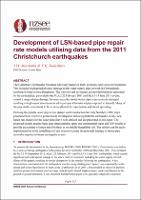| dc.contributor.author | Moratalla, Jose | |
| dc.contributor.author | Sadashiva, Vinod | |
| dc.date.accessioned | 2021-06-22T04:02:02Z | |
| dc.date.available | 2021-06-22T04:02:02Z | |
| dc.date.issued | 2021-04-14 | |
| dc.identifier.uri | https://repo.nzsee.org.nz/xmlui/handle/nzsee/2409 | |
| dc.description.abstract | The Canterbury Earthquake Sequence adversely impacted built, economic and social environments. This included widespread physical damage to the water supply pipe network in Christchurch, resulting in long service disruptions. The transient and permanent ground deformations generated by the earthquakes, particularly the Mw6.2 22 February 2011 and Mw6.0 13 June 2011 events, caused a range of pipe damage. In some areas the buried water pipes were severely damaged resulting in high repair rates (number of repairs per kilometre of pipe exposed to hazard). Many of the pipe faults were found to be in areas affected by liquefaction and lateral spreading.
Utilising the potable water pipe repair dataset and Liquefaction Severity Number (LSN) maps generated from extensive geotechnical investigation following both the earthquake events, new repair rate models for the water pipes have been derived and are presented in this paper. The proposed models require basic pipe characteristics (pipe size and material type) and LSN results to provide an estimate of repair rate for pipes in potentially liquefiable soil. The models can be easily implemented in a risk modelling tool and used to evaluate the potential damage to buried pipe networks exposed to future earthquake events. | |
| dc.language.iso | en | |
| dc.publisher | New Zealand Society for Earthquake Engineering | |
| dc.relation.ispartofseries | 2021;0155 | |
| dc.subject | Advancements in structural and geotechnical design and assessment | |
| dc.title | Developing LSN-based pipe repair rate functions utilising data from the 2011 Canterbury earthquakes | |
| dc.type | Article | |

